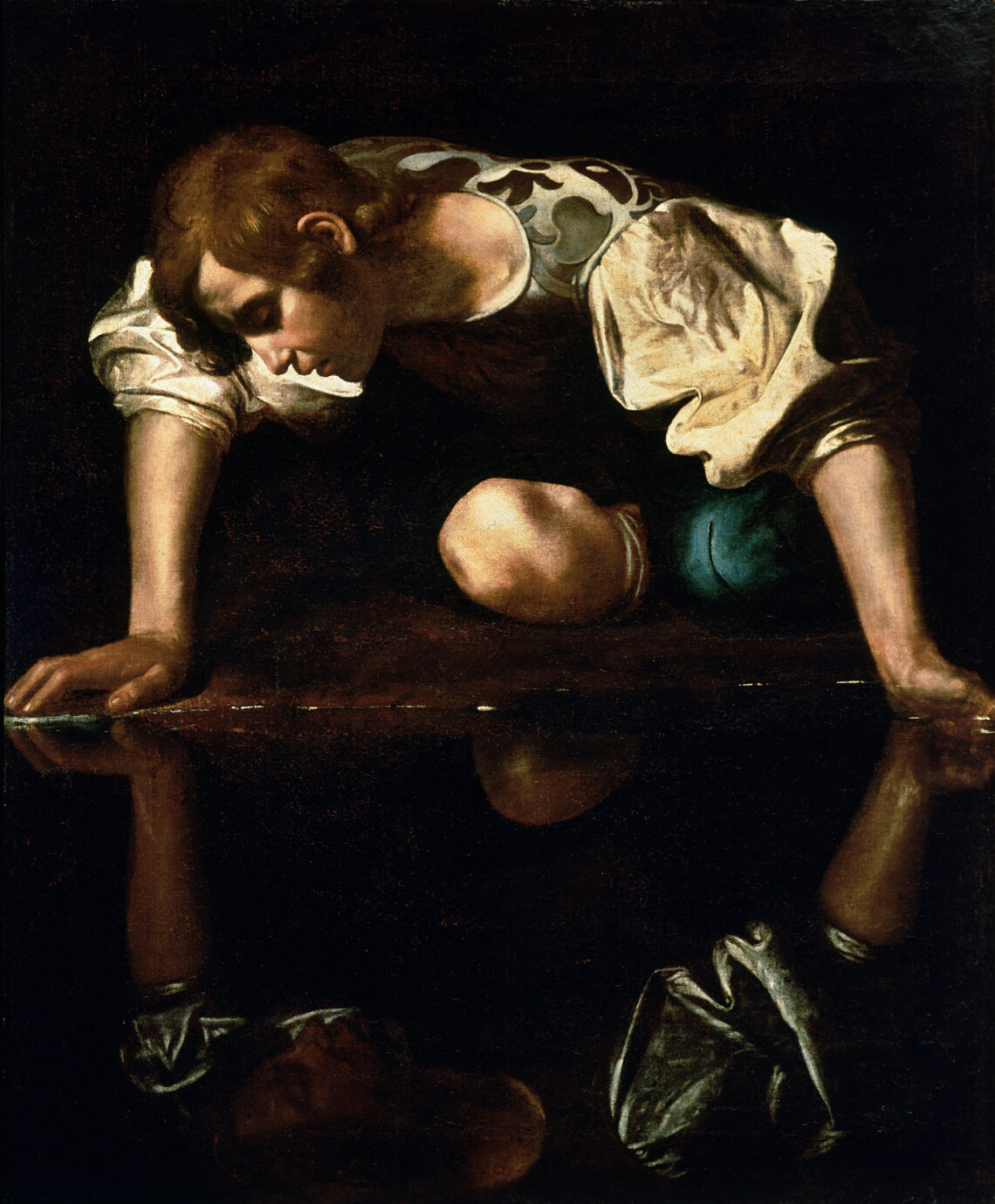Alright, buckle up, art enthusiasts! We’re about to embark on a journey through the intriguing world of Caravaggio, the artistic maverick who didn’t just paint pictures; he painted emotions. Today, we’re zooming in on one of his gems – Narcissus. This painting isn’t just a classical work; it’s a narrative spun with strokes of genius. So, grab your artistic glasses, and let’s dive into the life of Caravaggio, the drama of “Narcissus,” and a few juicy tidbits about this masterpiece.
Who was Caravaggio?

Let’s rewind to 1571, the year when Michelangelo Merisi da Caravaggio graced the world with his presence. Caravaggio wasn’t your typical artist; he was a rebel with a paintbrush. Born in Milan, he had this knack for capturing reality in a way that felt almost too real. His art wasn’t about polished perfection; it was about the messy, raw beauty of life. He majorly contributed in the renaissance era. He developed the technique into a key component of his style, engrossing figures in flickering light and dark shadows.
His Career
Picture this: a guy who could make a canvas pulse with life, but also a guy who loved stirring the pot. Caravaggio’s life wasn’t a serene walk in the park; it was more like a rollercoaster of artistic brilliance, controversy, and scandal. Caravaggio’s paintings were a testament to his undeniable talent, stealing the spotlight of the subject even when the man himself was knee-deep in trouble.
What is happening in Narcissus?

| Artist | Caravaggio |
| Date Painted | c. 1597-1599 |
| Medium | Oil on canvas |
| Genre | Baroque |
| Period | Baroque |
| Dimensions | 116 x 94 cm |
| Series/Versions | Single version |
| Where is it housed? | Galleria Nazionale d’Arte Antica, Rome |
Now, let’s shift our focus to Narcissus, Caravaggio’s take on the Greek mythology that’s been giving psychologists a field day for centuries. Imagine Narcissus, a figure so good-looking he could make Adonis look like an amateur. He spots his reflection in a pool, and bam! Cupid’s arrow of self-love hits him hard. Caravaggio’s version freezes this myth in time, capturing the exact moment when Narcissus is caught in the act of falling head over heels for himself.
The play of light and shadow in Narcissus isn’t just aesthetic gymnastics; it’s Caravaggio’s way of cranking up the emotional volume. The light accentuates Narcissus’ features, while the shadows add depth, making the whole scene a chiaroscuro masterpiece. It’s a visual symphony of vanity and tragedy, with Narcissus gazing into the water like he’s binge-watching the best show on Earth.
Analysis
Now, let’s dissect this masterpiece. Narcissus isn’t just a snapshot of a pretty moment; it’s a journey into the human psyche. The way light caresses Narcissus’ face and shadows cloak him adds layers of introspection. The water, like some cosmic mirror, reflects not just Narcissus’ image but the consequences of loving oneself a tad too much.
But here’s the kicker—Caravaggio chose to paint just one version of “Narcissus.” It’s like he’s saying, “This is it. This is the moment.” No sequels, no prequels; just one unfiltered, raw snapshot of self-love gone rogue. It’s as if Caravaggio wanted us to feel the weight of Narcissus’ realization that maybe, just maybe, he should’ve swiped left on his own reflection.
Interesting Facts
Lighting Magic: Caravaggio was the Dumbledore of chiaroscuro. This fancy term is just his way of saying, “I’ll make light and shadow dance, and it’ll be epic.” His paintings weren’t just visual feasts; they were emotional rollercoasters.
Life of Drama: Caravaggio wasn’t your typical painter who stayed cooped up in a studio. He was out there in the real world, getting into brawls, facing legal troubles, and living life like he was the protagonist of a Netflix series. His art mirrored his tumultuous life.
Keeping it Real: Narcissus isn’t some mystical fantasy. Caravaggio had this thing for keeping it real. His commitment to portraying the human experience with striking naturalism set him apart. You look at Narcissus, and you’re not just seeing a myth; you’re seeing a dude who could be your neighbor.
Artistic Legacy: Caravaggio didn’t fade away like yesterday’s news. His influence echoed through generations. The drama and emotion he infused into the Baroque era set the stage for artists who wanted to make art that punched you in the gut and made you feel alive.
Frequently Asked Questions
What is the story of Narcissus Caravaggio?
Michelangelo Merisi da Caravaggio painted Narcissus sometime between 1597 and 1599. Relatively recently discovered, this painting by Caravaggio dates from the early 1900s and portrays a scene from the Greek tale of Narcissus, a young man who falls in love with his reflection.
Conclusion
So, as you stand in front of Narcissus, it’s not just a painting—it’s an invitation to step into Caravaggio’s world. A world where art isn’t about perfection but about the messy, real, and unapologetically human. It’s a journey into self-discovery, a reminder that vanity, like a Greek tragedy, has its consequences. Narcissus isn’t just a masterpiece; it’s a conversation starter that transcends time, reminding us that even in the 21st century, we’re still gazing into pools of water, searching for reflections that tell us who we are.













